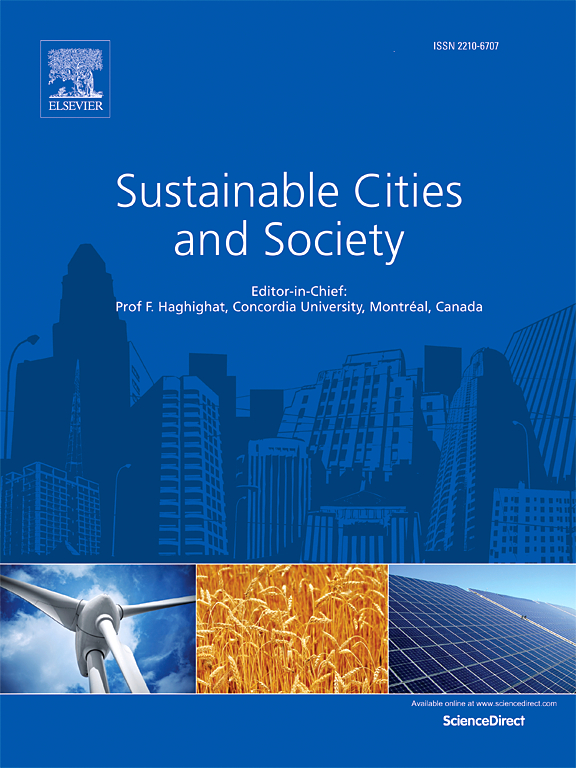Enhancing SWMM-UrbanEVA for continuous long-term water balance analysis of green infrastructure
IF 10.5
1区 工程技术
Q1 CONSTRUCTION & BUILDING TECHNOLOGY
引用次数: 0
Abstract
The EPA Stormwater Management Model (SWMM) is widely used to simulate runoff quantity and quality in drainage systems. With the SWMM-UrbanEVA extension, evapotranspiration of green infrastructure is better represented by incorporating vegetation-specific components, improving the analysis of the water balance for sustainable cities. However, accurate modeling of the long-term water balance is challenging due to the sensitivity of results to the chosen reporting time step. In SWMM-UrbanEVA, the results at each reporting time step represent instantaneous values. This leads to reduced accuracy in capturing temporal trends when larger reporting intervals are used to reduce the output file size. To address this limitation, we propose several changes to the code of SWMM-UrbanEVA. This adaptation, termed hereafter SWMM-UrbanEVA-AvgTimestep, computes and outputs the average of all computed time steps for subcatchment results between two reporting time steps. This change maintains the accuracy of water balance simulations by ensuring that total evaporation, infiltration, and runoff are correctly represented, regardless of the reporting time step. Our results indicate that while small reporting time steps are preferred for detailed peak analysis, the averaged results provide a reliable alternative for comprehensive, long-term planning and climate adaptation studies. In addition, we added a new option to export the results as a text file rather than just a binary file. It allows users easier access to the output results. SWMM-UrbanEVA-AvgTimestep empowers engineers and urban planners to analyze the long-term water balance, which is crucial for analyzing the performance of urban green infrastructure and climate adaptation for more sustainable cities.
加强SWMM-UrbanEVA对绿色基础设施进行连续的长期水平衡分析
美国环保署雨水管理模型(SWMM)被广泛用于模拟排水系统的径流数量和质量。随着SWMM-UrbanEVA的扩展,绿色基础设施的蒸散量通过纳入特定植被的成分来更好地代表,从而改进了可持续城市的水平衡分析。然而,由于结果对所选择的报告时间步长的敏感性,长期水平衡的准确建模是具有挑战性的。在SWMM-UrbanEVA中,每个报告时间步长的结果代表瞬时值。当使用较大的报告间隔来减小输出文件大小时,这会导致捕获时间趋势的准确性降低。为了解决这一限制,我们建议对SWMM-UrbanEVA的代码进行一些修改。这一适应,称为SWMM-UrbanEVA-AvgTimestep,计算并输出两个报告时间步之间子集水区结果的所有计算时间步的平均值。这种变化通过确保总蒸发、入渗和径流被正确地表示来保持水平衡模拟的准确性,而不管报告的时间步长如何。我们的研究结果表明,虽然小的报告时间步对于详细的峰值分析是首选的,但平均结果为全面、长期规划和气候适应研究提供了可靠的替代方案。此外,我们还添加了一个新选项,可以将结果导出为文本文件,而不仅仅是二进制文件。它允许用户更容易地访问输出结果。SWMM-UrbanEVA-AvgTimestep使工程师和城市规划者能够分析长期水平衡,这对于分析城市绿色基础设施的绩效和气候适应能力至关重要,从而实现更可持续的城市。
本文章由计算机程序翻译,如有差异,请以英文原文为准。
求助全文
约1分钟内获得全文
求助全文
来源期刊

Sustainable Cities and Society
Social Sciences-Geography, Planning and Development
CiteScore
22.00
自引率
13.70%
发文量
810
审稿时长
27 days
期刊介绍:
Sustainable Cities and Society (SCS) is an international journal that focuses on fundamental and applied research to promote environmentally sustainable and socially resilient cities. The journal welcomes cross-cutting, multi-disciplinary research in various areas, including:
1. Smart cities and resilient environments;
2. Alternative/clean energy sources, energy distribution, distributed energy generation, and energy demand reduction/management;
3. Monitoring and improving air quality in built environment and cities (e.g., healthy built environment and air quality management);
4. Energy efficient, low/zero carbon, and green buildings/communities;
5. Climate change mitigation and adaptation in urban environments;
6. Green infrastructure and BMPs;
7. Environmental Footprint accounting and management;
8. Urban agriculture and forestry;
9. ICT, smart grid and intelligent infrastructure;
10. Urban design/planning, regulations, legislation, certification, economics, and policy;
11. Social aspects, impacts and resiliency of cities;
12. Behavior monitoring, analysis and change within urban communities;
13. Health monitoring and improvement;
14. Nexus issues related to sustainable cities and societies;
15. Smart city governance;
16. Decision Support Systems for trade-off and uncertainty analysis for improved management of cities and society;
17. Big data, machine learning, and artificial intelligence applications and case studies;
18. Critical infrastructure protection, including security, privacy, forensics, and reliability issues of cyber-physical systems.
19. Water footprint reduction and urban water distribution, harvesting, treatment, reuse and management;
20. Waste reduction and recycling;
21. Wastewater collection, treatment and recycling;
22. Smart, clean and healthy transportation systems and infrastructure;
 求助内容:
求助内容: 应助结果提醒方式:
应助结果提醒方式:


